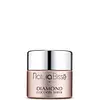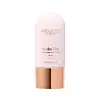Natura Bisse Diamond Cocoon Sheer Cream Versus Sculpted by Aimee Hydratint Moisturising Tinted Serum SPF 20
What's inside
What's inside
 Key Ingredients
Key Ingredients

 Benefits
Benefits

 Concerns
Concerns

 Ingredients Side-by-side
Ingredients Side-by-side

Water
Skin ConditioningCI 77891
Cosmetic ColorantDiisopropyl Sebacate
EmollientCaprylic/Capric Triglyceride
MaskingC15-19 Alkane
SolventC12-15 Alkyl Benzoate
AntimicrobialBeeswax
Emulsion StabilisingHydrogenated Polydecene
EmollientCetyl PEG/PPG-10/1 Dimethicone
EmulsifyingGlycerin
HumectantPolyglyceryl-4 Isostearate
EmulsifyingPropylheptyl Caprylate
EmollientSilica
AbrasiveDextrin Palmitate
EmulsifyingSaccharide Isomerate
HumectantTocopheryl Acetate
AntioxidantGlyceryl Linoleate
EmollientPaeonia Lactiflora Root Extract
Skin ConditioningTrehalose
HumectantGlyceryl Linolenate
EmollientPseudoalteromonas Ferment Extract
HumectantHydrolyzed Wheat Protein
Skin ConditioningSodium Hyaluronate
HumectantHydrolyzed Soy Protein
HumectantTripeptide-10 Citrulline
Skin ConditioningTocopherol
AntioxidantTripeptide-1
Skin ConditioningHydrolyzed Sodium Hyaluronate
Skin ConditioningSodium Acetylated Hyaluronate
HumectantSodium Hyaluronate Crosspolymer
HumectantOryza Sativa Extract
AbsorbentMagnesium Sulfate
PEG-30 Dipolyhydroxystearate
EmulsifyingDimethicone
EmollientStearalkonium Hectorite
Gel FormingDisodium EDTA
Propylene Carbonate
SolventCaprylyl Glycol
EmollientDecylene Glycol
Skin ConditioningPalmitic Acid
EmollientSodium Citrate
BufferingCitric Acid
BufferingButylene Glycol
HumectantSodium Lauroyl Glutamate
Lysine
Skin ConditioningXanthan Gum
EmulsifyingLecithin
EmollientMagnesium Chloride
Carbomer
Emulsion StabilisingPentylene Glycol
Skin ConditioningEthylhexylglycerin
Skin ConditioningCetyl Alcohol
EmollientTriethanolamine
BufferingPhenoxyethanol
PreservativePotassium Sorbate
PreservativeSodium Benzoate
MaskingParfum
MaskingCI 77492
Cosmetic ColorantCI 77499
Cosmetic ColorantCI 77491
Cosmetic ColorantMica
Cosmetic ColorantWater, CI 77891, Diisopropyl Sebacate, Caprylic/Capric Triglyceride, C15-19 Alkane, C12-15 Alkyl Benzoate, Beeswax, Hydrogenated Polydecene, Cetyl PEG/PPG-10/1 Dimethicone, Glycerin, Polyglyceryl-4 Isostearate, Propylheptyl Caprylate, Silica, Dextrin Palmitate, Saccharide Isomerate, Tocopheryl Acetate, Glyceryl Linoleate, Paeonia Lactiflora Root Extract, Trehalose, Glyceryl Linolenate, Pseudoalteromonas Ferment Extract, Hydrolyzed Wheat Protein, Sodium Hyaluronate, Hydrolyzed Soy Protein, Tripeptide-10 Citrulline, Tocopherol, Tripeptide-1, Hydrolyzed Sodium Hyaluronate, Sodium Acetylated Hyaluronate, Sodium Hyaluronate Crosspolymer, Oryza Sativa Extract, Magnesium Sulfate, PEG-30 Dipolyhydroxystearate, Dimethicone, Stearalkonium Hectorite, Disodium EDTA, Propylene Carbonate, Caprylyl Glycol, Decylene Glycol, Palmitic Acid, Sodium Citrate, Citric Acid, Butylene Glycol, Sodium Lauroyl Glutamate, Lysine, Xanthan Gum, Lecithin, Magnesium Chloride, Carbomer, Pentylene Glycol, Ethylhexylglycerin, Cetyl Alcohol, Triethanolamine, Phenoxyethanol, Potassium Sorbate, Sodium Benzoate, Parfum, CI 77492, CI 77499, CI 77491, Mica
Water
Skin ConditioningCentella Asiatica Extract
CleansingDimethicone
EmollientGlycerin
HumectantPhenyl Trimethicone
Skin ConditioningDipropylene Glycol
HumectantCaprylic/Capric Triglyceride
MaskingCetyl PEG/PPG-10/1 Dimethicone
EmulsifyingVinyl Dimethicone/Methicone Silsesquioxane Crosspolymer
Sodium Chloride
MaskingCeramide NP
Skin ConditioningSodium Hyaluronate
HumectantEthylhexylglycerin
Skin ConditioningMethicone
EmollientCarnosine
Skin ConditioningTocopherol
AntioxidantButylene Glycol
Humectant1,2-Hexanediol
Skin ConditioningLauryl PEG-9 Polydimethylsiloxyethyl Dimethicone
Skin ConditioningSorbitan Isostearate
EmulsifyingSorbitan Olivate
EmulsifyingStearalkonium Hectorite
Gel FormingTrimethylsiloxysilicate
EmollientTriethoxycaprylylsilane
Propylene Carbonate
SolventAluminum Hydroxide
EmollientSilica
AbrasivePhenoxyethanol
PreservativeCI 77891
Cosmetic ColorantIron Oxides
CI 77492
Cosmetic ColorantCI 77491
Cosmetic ColorantCI 77499
Cosmetic ColorantWater, Centella Asiatica Extract, Dimethicone, Glycerin, Phenyl Trimethicone, Dipropylene Glycol, Caprylic/Capric Triglyceride, Cetyl PEG/PPG-10/1 Dimethicone, Vinyl Dimethicone/Methicone Silsesquioxane Crosspolymer, Sodium Chloride, Ceramide NP, Sodium Hyaluronate, Ethylhexylglycerin, Methicone, Carnosine, Tocopherol, Butylene Glycol, 1,2-Hexanediol, Lauryl PEG-9 Polydimethylsiloxyethyl Dimethicone, Sorbitan Isostearate, Sorbitan Olivate, Stearalkonium Hectorite, Trimethylsiloxysilicate, Triethoxycaprylylsilane, Propylene Carbonate, Aluminum Hydroxide, Silica, Phenoxyethanol, CI 77891, Iron Oxides, CI 77492, CI 77491, CI 77499
Ingredients Explained
These ingredients are found in both products.
Ingredients higher up in an ingredient list are typically present in a larger amount.
Butylene Glycol (or BG) is used within cosmetic products for a few different reasons:
Overall, Butylene Glycol is a safe and well-rounded ingredient that works well with other ingredients.
Though this ingredient works well with most skin types, some people with sensitive skin may experience a reaction such as allergic rashes, closed comedones, or itchiness.
Learn more about Butylene GlycolThis ingredient is an emollient, solvent, and texture enhancer. It is considered a skin-softener by helping the skin prevent moisture loss.
It helps thicken a product's formula and makes it easier to spread by dissolving clumping compounds.
Caprylic Triglyceride is made by combining glycerin with coconut oil, forming a clear liquid.
While there is an assumption Caprylic Triglyceride can clog pores due to it being derived from coconut oil, there is no research supporting this.
Learn more about Caprylic/Capric TriglycerideThis ingredient is a high molecular weight silicone. It has emulsifying and skin conditioning properties.
Ci 77491 is also hydrated iron III oxide. It's sole purpose is to give a red/pink hue to products.
Iron III oxides are classified as inorganic chemicals for coloring.
Synthetically created Ci 77491 is considered safer than those naturally found. This is because the synthetically created version may contain less impurities. Iron oxides are generally non-toxic and non-allergenic.
Learn more about CI 77491Ci 77492 is also hydrated iron III oxide. It's sole purpose is to give a yellow hue to products.
Iron III oxides are classified as inorganic chemicals for coloring.
Synthetically created Ci 77492 is considered safer than those naturally found. This is because the synthetically created version may contain less impurities. Iron oxides are generally non-toxic and non-allergenic.
Learn more about CI 77492Ci 77499 is also hydrated iron III oxide. It is created from mixing red and black iron oxides. This helps give shades of darkness to a product.
Iron III oxides are classified as inorganic chemicals for coloring.
Ci 77891 is a white pigment from Titanium dioxide. It is naturally found in minerals such as rutile and ilmenite.
It's main function is to add a white color to cosmetics. It can also be mixed with other colors to create different shades.
Ci 77891 is commonly found in sunscreens due to its ability to block UV rays.
Learn more about CI 77891Dimethicone is a type of synthetic silicone created from natural materials such as quartz.
What it does:
Dimethicone comes in different viscosities:
Depending on the viscosity, dimethicone has different properties.
Ingredients lists don't always show which type is used, so we recommend reaching out to the brand if you have questions about the viscosity.
This ingredient is unlikely to cause irritation because it does not get absorbed into skin. However, people with silicone allergies should be careful about using this ingredient.
Note: Dimethicone may contribute to pilling. This is because it is not oil or water soluble, so pilling may occur when layered with products. When mixed with heavy oils in a formula, the outcome is also quite greasy.
Learn more about DimethiconeEthylhexylglycerin (we can't pronounce this either) is commonly used as a preservative and skin softener. It is derived from glyceryl.
You might see Ethylhexylglycerin often paired with other preservatives such as phenoxyethanol. Ethylhexylglycerin has been found to increase the effectiveness of these other preservatives.
Glycerin is already naturally found in your skin. It helps moisturize and protect your skin.
A study from 2016 found glycerin to be more effective as a humectant than AHAs and hyaluronic acid.
As a humectant, it helps the skin stay hydrated by pulling moisture to your skin. The low molecular weight of glycerin allows it to pull moisture into the deeper layers of your skin.
Hydrated skin improves your skin barrier; Your skin barrier helps protect against irritants and bacteria.
Glycerin has also been found to have antimicrobial and antiviral properties. Due to these properties, glycerin is often used in wound and burn treatments.
In cosmetics, glycerin is usually derived from plants such as soybean or palm. However, it can also be sourced from animals, such as tallow or animal fat.
This ingredient is organic, colorless, odorless, and non-toxic.
Glycerin is the name for this ingredient in American English. British English uses Glycerol/Glycerine.
Learn more about GlycerinPhenoxyethanol is a preservative that has germicide, antimicrobial, and aromatic properties. Studies show that phenoxyethanol can prevent microbial growth. By itself, it has a scent that is similar to that of a rose.
It's often used in formulations along with Caprylyl Glycol to preserve the shelf life of products.
This ingredient is a solvent. It helps dissolve active ingredients and alter the texture of products.
Propylene Carbonate is commonly used in makeup and with clay, such as montmorillonite or bentonite.
Studies show this ingredient to be safe for cosmetics. When it is undiluted, it can cause skin irritation. (It is always diluted in skincare and makeup). This ingredient is water-soluble.
Propylene Carbonate is created from propylene glycol and carbonic acid.
Learn more about Propylene CarbonateSilica, also known as silicon dioxide, is a naturally occurring mineral. It is used as a fine, spherical, and porous powder in cosmetics.
Though it has exfoliant properties, the function of silica varies depending on the product.
The unique structure of silica enhances the spreadability and adds smoothness, making it a great texture enhancer.
It is also used as an active carrier, emulsifier, and mattifier due to its ability to absorb excess oil.
In some products, tiny microneedles called spicules are made from silica or hydrolyzed sponge. When you rub them in, they lightly polish away dead skin layers and enhance the penetration of active ingredients.
Learn more about SilicaSodium Hyaluronate is hyaluronic acid's salt form. It is commonly derived from the sodium salt of hyaluronic acid.
Like hyaluronic acid, it is great at holding water and acts as a humectant. This makes it a great skin hydrating ingredient.
Sodium Hyaluronate is naturally occurring in our bodies and is mostly found in eye fluid and joints.
These are some other common types of Hyaluronic Acid:
Learn more about Sodium HyaluronateStearalkonium Hectorite is a clay-derived ingredient used to thicken a product and help create a gel-like texture.
Tocopherol (also known as Vitamin E) is a common antioxidant used to help protect the skin from free-radicals and strengthen the skin barrier. It's also fat soluble - this means our skin is great at absorbing it.
Vitamin E also helps keep your natural skin lipids healthy. Your lipid skin barrier naturally consists of lipids, ceramides, and fatty acids. Vitamin E offers extra protection for your skin’s lipid barrier, keeping your skin healthy and nourished.
Another benefit is a bit of UV protection. Vitamin E helps reduce the damage caused by UVB rays. (It should not replace your sunscreen). Combining it with Vitamin C can decrease sunburned cells and hyperpigmentation after UV exposure.
You might have noticed Vitamin E + C often paired together. This is because it is great at stabilizing Vitamin C. Using the two together helps increase the effectiveness of both ingredients.
There are often claims that Vitamin E can reduce/prevent scarring, but these claims haven't been confirmed by scientific research.
Learn more about TocopherolWater. It's the most common cosmetic ingredient of all. You'll usually see it at the top of ingredient lists, meaning that it makes up the largest part of the product.
So why is it so popular? Water most often acts as a solvent - this means that it helps dissolve other ingredients into the formulation.
You'll also recognize water as that liquid we all need to stay alive. If you see this, drink a glass of water. Stay hydrated!
Learn more about Water